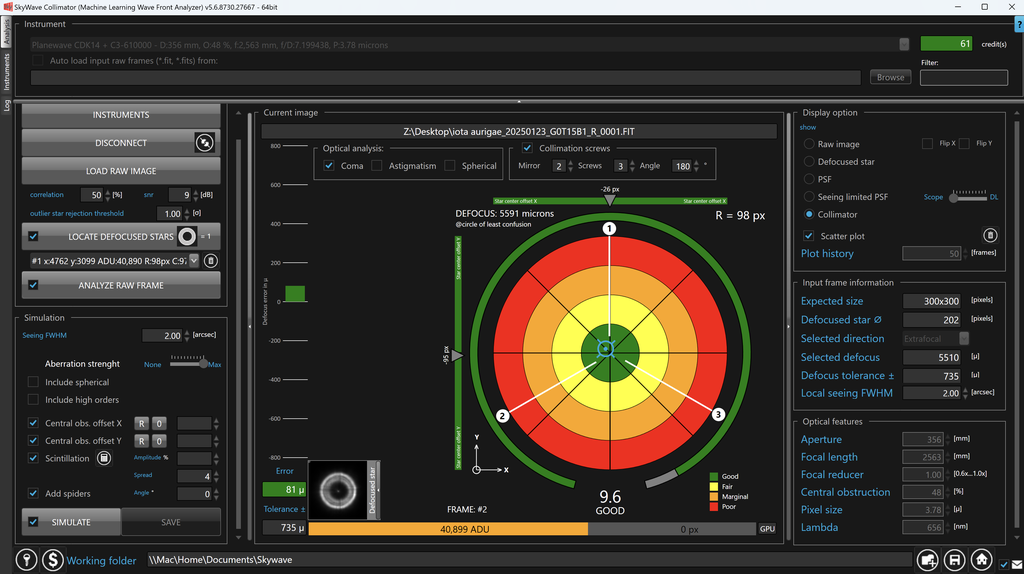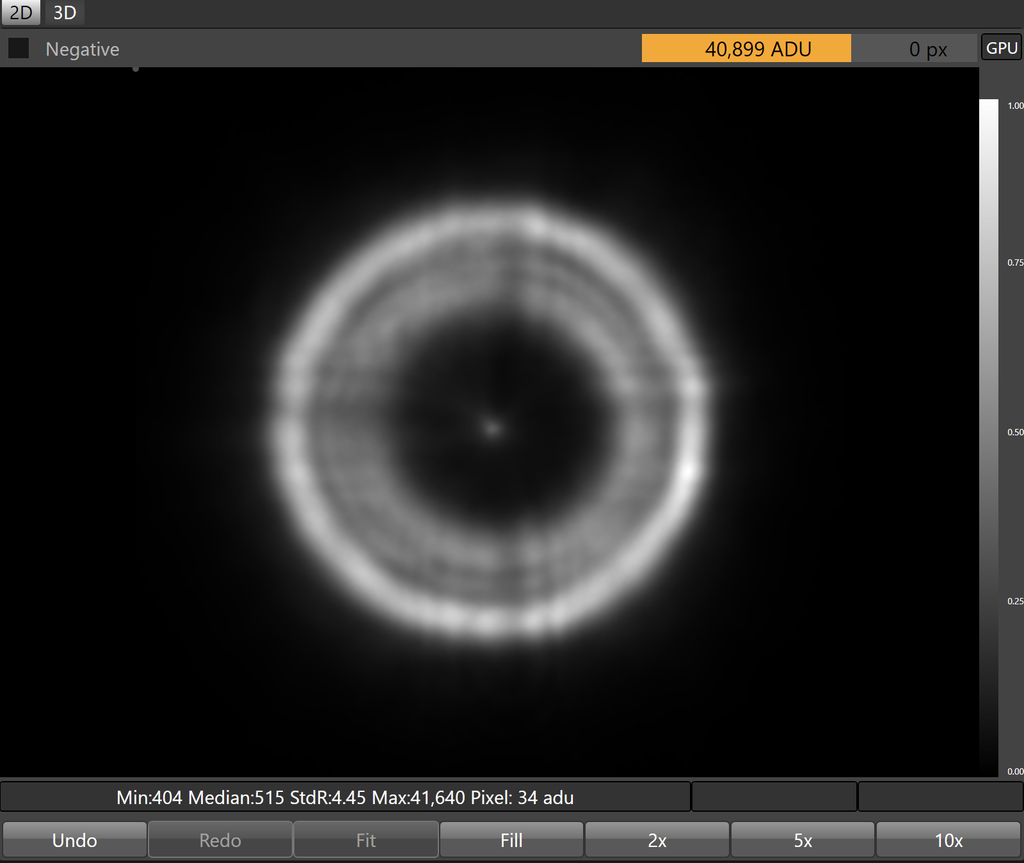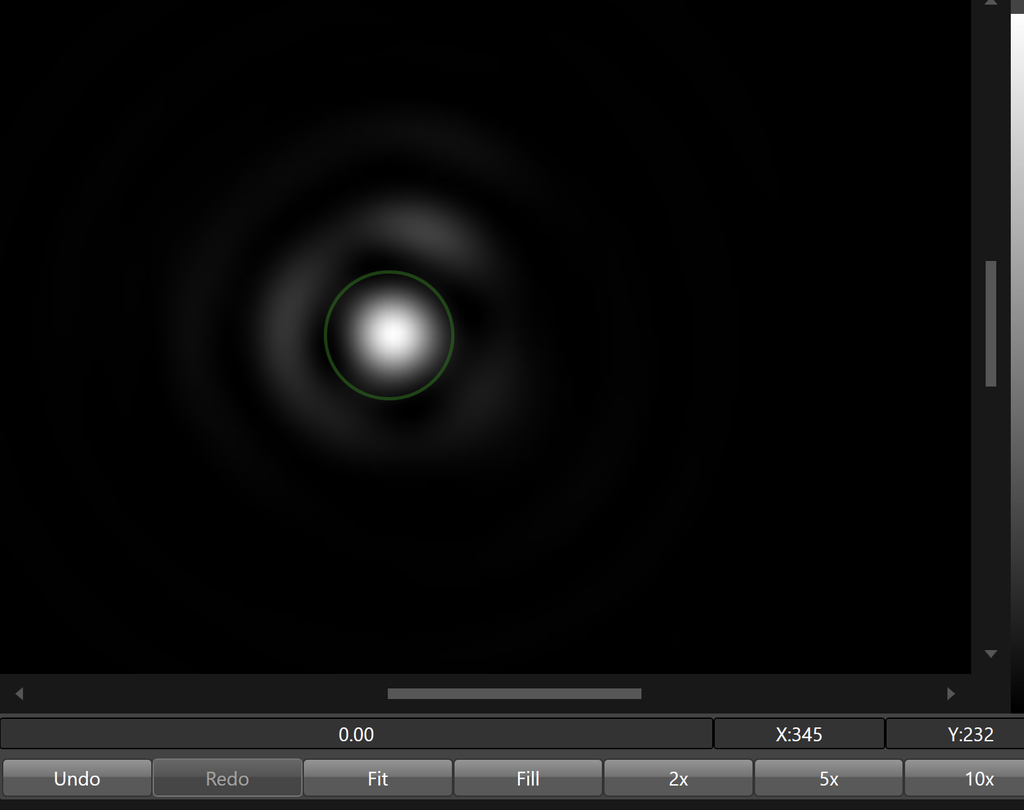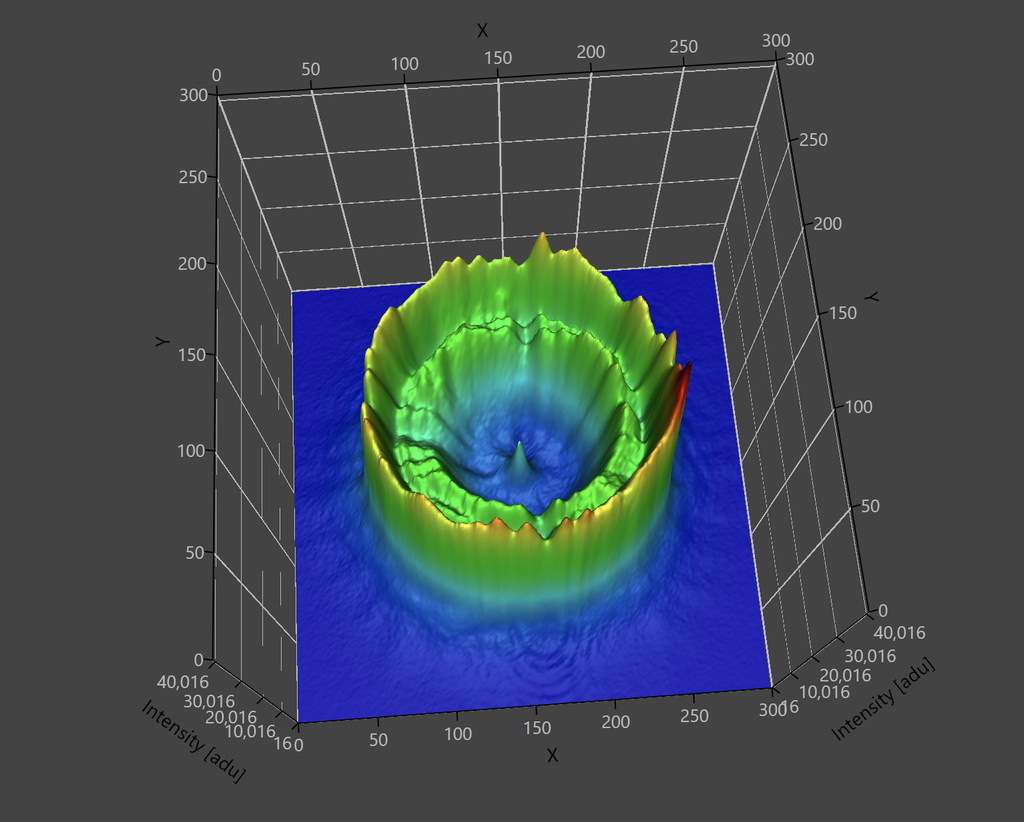Skywave results:

Defocused star:

PSF:

PSF 3D:

...
·
 |
|---|
@John Hayes is pretty experienced with this stuff, I bet he could answer your question. Clear skies, Nooa |
...
·
 |
|---|
Yep, you are slightly offset. On a normal RC I'd try to get it spot on but no idea how difficult that is with a CDK.
|
...
·
 |
|---|
It looks to my eye that the software and image agree. That 0.4 in misalignment is enough to be visible in the star test. Collimation isn't perfect until the star test says it is.
|
...
·

·
1
like
|
|---|
The star is a little oversaturated (yellow ADU bar at the bottom). Repeat making sure that everything is green. Results tend to be slightly unpredictable if the star is too far from the defocus tolerance or the saturation threshold. If results are confirmed, i would trust the result skywave is giving over a perfectly aligned defocused star. The mechanical center is not always the right alignment and optics might have a different alignment (this is very well explained in their documentation and it's the reason why quantitative collimation using skywave is better than qualitative collimation using manual tools/defocused star) |
...
·
 |
|---|
I would disagree with this. If the software is driving a result at the focal plane that's not distributing the energy evenly then I can't see how that can be the best solution.
|
...
·
 |
|---|
Tony Gondola: Question is, can you actually find with this particular mechanical/optical configuration, a perfect setup that distributes the energy better than what we see here? Maybe this is the best result that you can obtain with this particular scope. Gaston would be best in providing a more detailed answer, but i'd rather take this result over a perfectly mechanically centered setup that doesnt bring the same energy distribution and score. That's the whole point of using skywave in the first place. EDIT: with that said as i mentioned before the analysis was performed in imperfect conditions so i would wait until the OP performs the test again |
...
·

·
5
likes
|
|---|
First, SKW is trained to be able to distinguish between wavefront aberration and decentered optics. The fact that your defocused donut is off-center is probably because your secondary mirror is slightly decentered in the pupil. That’s possible simply because the secondary mirror is spherical, which decreases the sensitivity of the system to decenter. My guess is that may also be why the Poncaire spot is slightly off center as well. As for the PSF being asymmetric, that’s almost certainly due to minor radially asymmetric errors in the wavefront. That’s a characteristic of manufacturing errors in the optics and at some level, it’s pretty common for all scopes. From what I can see in your data, I wouldn’t worry about it. Overall, your alignment looks quite good and so do the optics. It looks like you have quite a nice system! John |
...
·
 |
|---|
I always thought that the corrected DK used a spherical secondary and an elliptical primary with a correcting lens group. Is the Planewave version a modification of the original design?
|
...
·

·
1
like
|
|---|
Hi Willem, First, congrats on a highly collimated system! Second, the whole point of wave-front analysis (AI based or not) is that the usual “concentric circle” method of collimation is unreliable. The reason is that the defocused image being off-center can happen in two cases : 1) miscollimation (wave-front error) and 2) the geometric axis of the secondary mirror is off-center. Note that case (2) would not cause virtually any degradation of a focused image. The reason is the secondary mirror for a CDK is spherical, which has infinite *optical* axes, and it’s the optical axis, not the geometric axis that counts. If the your defocused image is really caused by miscollimation, your focused star PSF would look way worse than that. Loosely speaking, if you use the defocused star method, what matters more is if the donut is evenly illuminated, not if the circles are concentric. The two conditions do not always overlap. Yuxuan |
...
·
 |
|---|
andrea tasselli: RC and CDK are different systems. The RC has a hyperbolic secondary while CDK has a spherical one. CDK can reason perfect collimation even if the secondary mirror is offset geometrically. Not the case for RC. |
...
·
 |
|---|
Rotation about the secondary pole to correct for the offset should cause a slight unevenness in illumination, I'd reckon.
|
...
·

·
1
like
|
|---|
John Hayes: While a much better explanation than I would be able to muster, I also wanted to post that I would not bother touching the collimation with a result like that. |
...
·
 |
|---|
andrea tasselli: True, but that’s a higher order small quantity compared to vignetting. In my experience noticeable unevenness in illumination is more commonly caused by the decentering of the sensor. |
...
·
 |
|---|
Tony Gondola: I’m sorry Tony. You are correct. For some reason, I was thinking about a SCT. Only the secondary is spherical in the CDK design. John |
...
·

·
1
like
|
|---|
John Hayes: Thank you John. Coming from an expert like yourself, this sounds very reassuring. |
...
·

·
2
likes
|
|---|
Thank you all for your valuable insight, advice and recommendations. It looks like the shared opinion is that the optical performance of the system is great. The slightly decentered donut is probably related to the secondary mirror being a bit off-center, but this is not something that should have a negative effect on image quality. So I'll leave it as is and check again some time in the future. I really like the Skywave software. It's an objective measurement and can isolate a lot of different types of optical issues. It's easy to use and allows for relevant feedback on a forum like this by simply posting a few screenshots. Once again, thank you all! |
...
·
 |
|---|
Collimatuon is good but not quite perfect - one of the mirrors has a very slight tilt, the question is which one. With these scopes (and my Rumak) “near enough” is good, but when you nail “perfect” there can be a significant improvement. |